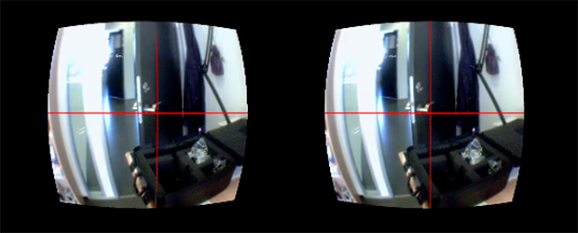
There’s a lot you can do with eye and gaze tracking, when it comes to interface design, so when [Diako] got his hands on an Oculus Rift, there was really only one thing to do.
Like a few other solutions for eye tracking we’ve seen, [Diako] is using a small camera with the IR filter removed to read the shape and location of an eye’s pupil to determine where the user is looking. This did require cutting a small hole near one of the Oculus’ eye cups, but the internal camera works great.
To get a window to the world, if it were, [Diako] slapped another camera onto the front of the Oculus. These two cameras are fed into the same computer, the gaze tracking is overlaid with the image from the front of the headset, and right away the user has a visual indication of where they’re looking.
Yes, using a computer to know where you’re looking may seem like a rather useless build, but stuff like this is used in research and extraordinarily high tech heads up displays. Although he’s not using the motion tracking on the Oculus, if [Diako] were to do so, he’d have the makings of one of the most powerful heads up displays possible.















Oh look, someone’s already put together a DIY version of one of the things I’m afraid will most likely be incorporated into the rift itself. Fantastic.
This is one feature I’d really rather facebook not get the data on…the advertisements are invasive enough as it is, imagine if they were getting real time data based on what adds you looked at for statistically longer periods of time.
I imagine we’d end up with a lot more porn ads.
Or a hands free mouse.
AND a hands free mouse.
If you’re paranoid about Facebook gathering usage data, you’re better off not even bothering with the Oculus. I on the other hand hope they include eye-tracking as it has a lot of really great uses. Personally, I trust the hackers out in the world enough to know that if usage data is being collected, they will find a way to prevent it.
Buy one for the hardware — people are going to hack them. 3 months after release *tops* for a decent opensource firmware
It IS possible for a company to acquire another company without swallowing it hole. Apparently Facebook has a pretty good track record for letting the companies do their own thing. But sure, put that tin foil hat on and shit :P
Isn’t the Oculus open source? Meaning even if Facebook did incorporate ads or data garthering like that then we can just run an open source firmware for it. Even if it isnt open source I can gaurentee that if they did start data gathering and putting ads in it, open source software to run the rift will be developed by the community.
no. not at all.
Eye tracking is a pretty important feature for VR:
http://doc-ok.org/?p=756
http://doc-ok.org/?p=764
Now make it creepy, by putting two round shaped LCD displays on the front to show two eyes moving according to the eye movements. Now you have something!!! Have a conversation with THAT and see if you don’t want to look away after about a minute.
Eye tracking seems also pretty important to minimize distortions in a rendered scene.
Okreylos on youtube has a pair of videos that explain the situation:
https://www.youtube.com/watch?v=lsKuGUYXHa4
https://www.youtube.com/watch?v=SC9vbV-zjBk
Reblogged this on Carpet Bomberz Inc. and commented:
Now THAT is amazing, but not out of the question either. Why can’t you do eye tracking with an Oculus Rift? How much more hardware and extra calibration steps would you need to do data collection like this? Seems like a great value add for folks doing Brain and Cognitive Science research with 3D test rigs. Maybe this will open up a market for Oculus Rift as research device.
Giordi LaForge viewer here we come
Someone needs to figure out how to implement measuring the focal distance of the eye, with very fast response. That, with eye tracking, will be the start of truly realistic VR.
I think just having the game do a DOF focal point to whatever distance the eye is currently looking at, at having the focal point “move” just as fast as the average eye can would make it extremely realistic. It would only not work if the user tried to trick it, eg: manually focus on things.
The problem is that the rift simply cannot deal with your eye changing focal depth. That’s one of the major problems with current VR tech, in my opinion. You’ve got depth cues via parallax but not by focusing.
You either need a pinhole projector (yes, that’s a thing) or active optics to actively defocus what you’re looking at.
I think he meant blurring things by software, and leaving the eye focusing as it is now.
“as it were”
I just hope someone builds a red LED strip for the face that can represent eye focus on top of this build. Cylons everywhere.
All the hoopla about tracking your eyes to correct the optics and rendering is forgetting the part of population who live with lenses in front of their eyes, which distort the view based on the same geometrical constraints as the VR headset.
And it’s not an actual problem because you simply get used to the distortion in a matter of minutes to the point that swapping to contact lenses that don’t have the distortion make the wearer disoriented for a moment.
I used to have glasses that had wide field distortion towards the sides, and adapting to glasses that didn’t have that took about half a day.